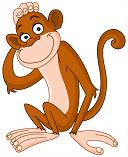
Quiz Monkey
What do you want to know?
 |
Quiz Monkey |
| Mythology |
| Norse |
| Ask (created by the gods from an ash tree) and Embla are the Norse equivalents of (Biblical characters) |
|
Adam and Eve | |
| Home of the Norse gods |
|
Asgard | |
| Second son of Odin, associated with light, beauty, love and happiness: killed by a magical spear of mistletoe, created by Loki |
|
Baldr (Balder, Baldur) | |
| Name of the rainbow bridge that joins Asgard to Earth |
|
Bifrost (BEE–vrost) | |
| The two collections of folk tales that our knowledge of ancient Norse mythology is derived from |
|
Eddas | |
| Son of the dwarf king Hreidmar: turned into a dragon after being affected by the curse of Andvari's ring and gold, and was slain by his nephew, Sigurd (Siegfried). |
|
Fafnir | |
| Wife of Odin, mother of Thor – after whom Friday is named |
|
Frigg, Frigga | |
| Goddess of married love, fertility, and the hearth; owned a necklace called Brisingamen; rode a chariot pulled by two cats |
|
Freyja, Freya | |
| Sleipnir, Doomstead, Skinfaxi and Hrímfaxi (associated with Odin, the Fates, Day and Night respectively) are all |
|
Horses | |
| Land of the giants – used for the mountain range that includes Norway's highest peak |
|
Jotunheim | |
| God of mischief – caused the death of Baldr by creating a magical spear from mistletoe |
|
Loki | |
| Father of Hel, the wolf Fenrir, the world serpent Jörmungandr, and mother (in the form of a mare)
of the eight–legged horse Sleipnir | |||
| Name for the realm of man (Earth) |
|
Midgard | |
| The only object on earth that didn't vow never to hurt Baldr (and did indeed cause his death; in an alternative version, this was the name of a sword used by his love rival) |
|
Mistletoe | |
| Often compared to the Greek Fates: Urd [fate], Skuld [necessity], and Verdandi [being] |
|
Norns | |
| The supreme god, ruler of Asgard |
|
Odin | |
| Rode an eight–legged horse called Sleipnir; often accompanied by his animal companions and familiars Geri and Freki, Huginn and Muninn | |||
| Final battle between the forces of good (represented by the gods) and evil (the giants or Jotunn) |
|
Ragnarok | |
| Huginn and Muninn, who fly all over Midgard and bring information back to Odin, are (type of bird) |
|
Ravens | |
| Kills the dragon Fafnir with his sword Gram ("wrath"), and bathes in its blood to become immortal |
|
Sigurd (Siegfried) | |
| Odin's most famous son: rode a chariot drawn by two goats called Tanngrisnir (the one with sparse teeth) and Tanngnjóstr (the one that grinds his teeth); wielded a hammer called Mjölnir – normally translated as "that which smashes" |
|
Thor | |
| God of war, after whom one of the days of the week is named |
|
Tiw | |
| Hall in Odin's palace, reserved for heroes killed in battle |
|
Valhalla | |
| Handmaidens of Odin, sent to battlefields to select those worthy of a warrior's death |
|
Valkyrie | |
| Legendary blacksmith of Norse and Anglo–Saxon mythology; associated with a burial mound in the Berkshire Downs (also appears in Beowulf) |
|
Wayland (Welund) the Smith | |
| Geri and Freki – companions or familiars of Odin – are (type of animal) |
|
Wolves | |
| The "world tree" that connects the nine worlds of Norse mythology, whose branches reach far into the heavens, and where the gods assemble every day | Name |
|
Yggdrasil |
| Type of tree |
|
Ash | |
© Haydn Thompson 2017–24